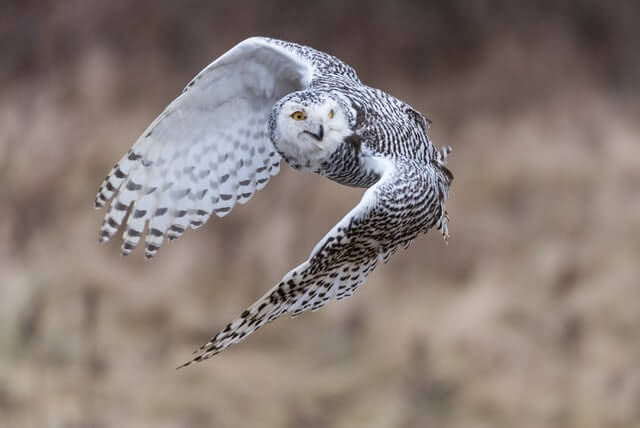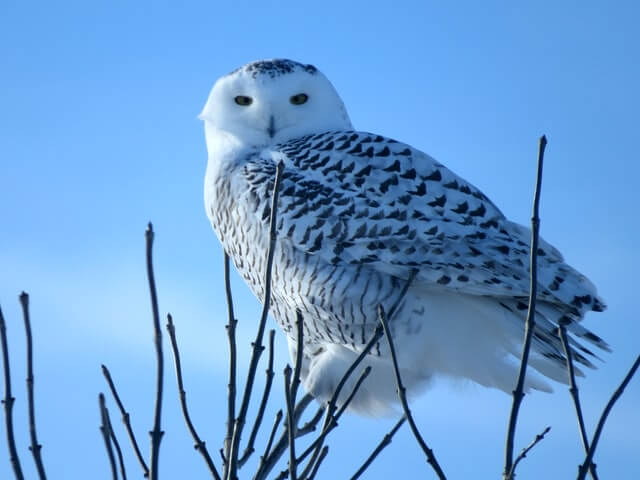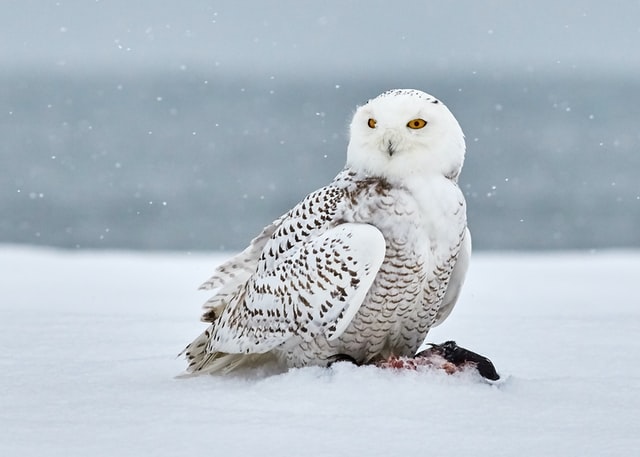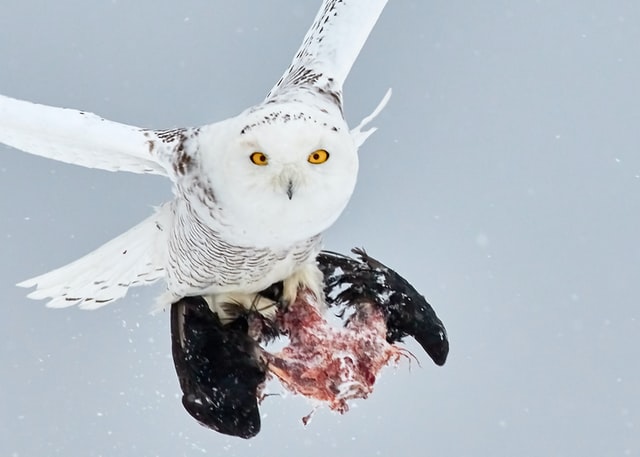In this article, we’ll take a closer look at 48 fun facts about snowy owls that will leave you amazed by these incredible birds. From their unique features to fascinating behaviors, these owls are full of surprises. So, whether you’re an owl enthusiast or just curious about these majestic creatures, keep reading for some mind-blowing details you won’t want to miss!
Click the Play button below to listen to our podcast:
Table of Contents
- 1 Snowy Owl Overview
- 2 Fun Facts About Snowy Owls
- 2.1 Snowy Owls can fly at speeds up to 80 km/h (50 mph).
- 2.2 They have a heart rate of 200 bpm when resting.
- 2.3 They are the 2nd largest owl in North America.
- 2.4 Snowy Owls find refuge in Canada’s Arctic regions.
- 2.5 Snowy Owls swallow their prey whole.
- 2.6 They build their nests on the ground.
- 2.7 Snowy Owls can detect prey through the pads of their feet.
- 2.8 The Snowy Owl has insulating feathers.
- 2.9 They have the potential to live up to 30 years.
- 2.10 The Snowy Owl is a diurnal raptor.
- 2.11 A baby Snowy Owl is called an “Owlet.”
- 2.12 They can see 3x better than humans.
- 2.13 Snowy Owls will “Hiss” or “Bark” if threatened.
- 2.14 They will “Hoot” or “Coo” when courting and mating.
- 2.15 Snowy Owls Are Monogamous, But Not Lifelong Partners.
- 2.16 They can rotate their heads 270 degrees.
- 2.17 Snowy Owls are the heaviest species of owl in North America.
- 2.18 Females are 20% larger than males.
- 2.19 Snowy Owls are the official bird of Quebec.
- 2.20 Snowy Owls will eat 3-5 lemmings each day.
- 2.21 The Snowy Owl is a bird of many names.
- 2.22 Snowy Owls need a pound of food every day to survive
- 2.23 Snowy Owls digest flesh and regurgitate bones.
- 2.24 Baby Owlets are born blind and without feathers.
- 2.25 Their skeleton makes up about 7-9% of its total body weight.
- 2.26 Snowy Owls use sound waves to hunt for prey.
- 3 Frequently Asked Questions
- 4 Author
Snowy Owl Overview
- Identification: The Snowy Owl’s adult male’s plumage is snow-white, and can be identified by its three black bars on the tail feathers. The females are also white with black spots and barring throughout the body and wings. The Snowy Owl’s legs are covered in feathers up to the toes, but the talons themselves are black. The eyes have yellow irises with black pupils, and the beak is short with a downward hook, for tearing into flesh.
- Length: 20.5-28.0 in (52-71.1 cm)
- Weight: 56.5-104.1 oz (3.5-6.5 lbs.)
- Wingspan: 49.2-57.1 in (125-145 cm)
- Order: Strigiformes
- Family: Strigidae
- Genus: Bubo
- Scientific Name: Bubo scandiacus
- Range: Its range extends from the Arctic tundra to the northern regions of North America, Europe, Asia and Russia.
- Migration: Some small populations may migrate to southern states such as Texas, Georgia or Florida.
- Habitat: Arctic tundra, boreal forests, prairies, mountainsides and even agricultural fields.
- Diet: Mainly eat small mammals such as lemmings, voles, hares, shrews, ground squirrels and carrion, but they will occasionally hunt for other prey such as ducks or geese.
- Global Population: est. 100,000 individuals.
- Breeding Pairs Population: est. 28,000 pairs.
- Conservation Status: Listed Least Concern (Population is decreasing)
- Nesting Habits: It is common for these birds to nest on ground level, often in open fields where they can easily see predators coming from a distance. They will typically build their nests near some type of vegetation which provides protection against wind and precipitation while allowing for warmth during colder months. These birds prefer nesting near water, as well.
- Incubation Length: 32 days
- Nestling Length: 18-25 days
- Clutch Size: 3-11 eggs
- Number of Broods: 1 Brood
Fun Facts About Snowy Owls
Snowy Owls can fly at speeds up to 80 km/h (50 mph).
Snowy Owls are one of the most widespread owl species in North America. They can fly at speeds up to 80 km/h (50 mph) and hunt in open areas like tundra, grasslands, wetlands, and farm fields.
They have a heart rate of 200 bpm when resting.
Snowy Owls have an average heart rate of 200 beats per minute when resting. This is because of energy metabolism and thermoregulation. Snowy owls live in the Arctic, so they need to be able to keep their body temperature up as well as expend a lot of energy looking for food during the winter months. When they hunt, their heart rates go up and can reach 288-300 beats per minute!
They are the 2nd largest owl in North America.
Snowy owls are the second-largest owl in North America. They can grow up to 71 cm (28 inches) tall with a wingspan of nearly 1.5 meters (5 feet). These powerful birds weigh between 1.4 and 3 kg (3 to 6.5 pounds), with females being slightly larger than males.
Snowy Owls find refuge in Canada’s Arctic regions.
Snowy owls typically migrate south for the winter, but some remain year-round in Canada’s Arctic regions, such as Ontario’s Wapusk National Park, which supports up to 150 individuals. To protect these iconic birds, Canada has established protected areas and strict anti-hunting laws. While they are usually found in northern habitats, sightings have been recorded as far south as Texas and California during the summer months.
Snowy Owls swallow their prey whole.
The snowy owl’s stomach can stretch up to three times its original size, allowing it to swallow prey one-third of its own size! These owls consume their prey whole, and their stomach is divided into two sections: the gizzard and the proventriculus.
As food moves through these organs, indigestible parts like bones and fur are compacted into small pellets called boluses. Instead of digesting these materials, snowy owls later regurgitate them as part of their natural digestive process.
They build their nests on the ground.
Snowy owls nest directly on the ground, often choosing abandoned burrows, natural depressions, or excavation sites as nesting spots. These locations provide some protection from harsh Arctic winds. While the female stays at the nest to incubate the eggs and care for the young, the male takes on the role of provider, hunting for food to sustain the family.
Snowy Owls can detect prey through the pads of their feet.
Snowy owls can detect the movements of their prey through vibrations sensed in the pads of their feet. These specialized pads contain thousands of nerve endings, allowing the owls to pick up subtle ground movements even when their prey is hidden from sight or silent. This unique adaptation helps them locate food efficiently, ensuring they can hunt successfully in any season.
The Snowy Owl has insulating feathers.
One of the most fascinating adaptations of snowy owls is their insulating feathers. These specialized feathers contain hollow fibers that trap air, creating an effective barrier against the cold. This insulation helps them retain body heat from the previous night, allowing them to stay warm even in freezing daytime temperatures.
They have the potential to live up to 30 years.
Snowy owls typically live around 15 years in the wild, but in captivity, they can survive much longer—up to 30 years. The longest recorded lifespan for a snowy owl was 28 years in captivity, highlighting the impact of a controlled environment on their longevity.
The Snowy Owl is a diurnal raptor.
The snowy owl is a diurnal raptor, meaning it hunts during the day and rests at night—unlike most other owls, which are nocturnal. This adaptation helps snowy owls make the most of the Arctic’s long daylight hours, giving them more opportunities to spot and catch prey in their open, snow-covered habitat.
A baby Snowy Owl is called an “Owlet.”
A baby snowy owl is called an “owlet.” Owlets belong to the family Strigidae, which includes all true owls. The term “owlet” comes from Old English and means “little owl,” perfectly describing these fluffy, wide-eyed chicks as they grow into formidable Arctic predators.
They can see 3x better than humans.
The Snowy Owls eyes are specially adapted for seeing in low light conditions, even when there’s snow on the ground. They can see three times better than humans because they have a reflective layer called tapetum lucidum under their retina. The tapetum reflects incoming light back through the retina so it can be absorbed again, allowing them to see better in the dark.
Snowy Owls will “Hiss” or “Bark” if threatened.
Snowy Owls are known to have many types of vocalizations, including screeching and barking when threatened. These alarms help to warn other owls in the area about potential dangers which could be lurking around them unseen
They will “Hoot” or “Coo” when courting and mating.
Snowy owls are one of the few species that “hoot” or “coo” when courting and mating. This is to attract a mate as well as to show off their vocal range, which is a key factor in choosing a partner.
Owls have different calls for different purposes: territorial, courtship, parental care and alarms. When they hoot, they do so with long low notes followed by short high-pitched ones.
Snowy Owls Are Monogamous, But Not Lifelong Partners.
Snowy owls are usually monogamous and often form long-term pair bonds, but they typically stay together for just one breeding season. In some cases, males may mate with two females, with their nests spaced about a kilometer apart. Their breeding season typically occurs between May and June, with both parents playing a role in raising their young.
They can rotate their heads 270 degrees.
Snowy owls have incredibly flexible necks that allow them to rotate their heads 270 degrees in both directions. This unique ability enables them to see nearly everything around them without moving their eyes. The key to this impressive flexibility lies in the extra vertebrae in their necks.
Owls have 14 neck vertebrae—7 more than humans—along with just one occipital articulation with their cervical vertebrae. Unlike humans, who have two of these articulations, snowy owls lack a second joint between their skull and spine, which contributes to their remarkable head-turning ability.
Snowy Owls are the heaviest species of owl in North America.
Snowy Owls are the heaviest species of owl in North America, usually weighing approximately 4.5 pounds. This makes them significantly heavier than most other owls. The reason for this is that they have a thick layer of feathers which insulates their body from cold temperatures
Females are 20% larger than males.
Female snowy owls are 20% larger than their male counterparts, with an average mass of 2.3 kg compared to the male’s average of 1.8 kg. The size difference is mainly due to the varying energy needs during the mating season when food sources are scarce.
Females require more mass to survive the long, harsh winter months without food, so they grow larger to store energy while hunting small rodents. Additionally, the extra size helps females accumulate fat reserves necessary for reproduction, ensuring they can endure the challenging conditions of the Arctic.
Snowy Owls are the official bird of Quebec.
The snowy owl became the official bird of Quebec, Canada in 1987. Quebec is a province in eastern Canada that was first colonized by France. It is currently one of the most populous provinces, with 8.4 million people living there.
One of its symbols are the majestic snowy owls, which have been spotted all over Quebec’s territory for centuries. They are so iconic to the province that they were declared as their official bird in 1987.
Snowy Owls will eat 3-5 lemmings each day.
Snowy owls are known for their impressive hunting skills and hefty appetites. Their diet primarily consists of lemmings, small rodents about 2-3 inches long with brown fur. During the breeding season, snowy owls typically consume 3-5 lemmings per day, amounting to over 1,600 lemmings in a single year. This diet helps them maintain the energy needed to thrive in the harsh Arctic environment.
The Snowy Owl is a bird of many names.
The snowy owl is known by many names, such as the Great White Owl, Snow Owl, Ghost of the Arctic, Ermine Owl, Tundra Ghost, Ookpik, Scandinavian Nightbird, White Terror of the North, and Arctic Owl. Throughout history, it has been both feared as a harbinger of death and misfortune and revered for its exceptional nocturnal hunting abilities by cultures from the Inuit to the Navajo people.
Snowy Owls need a pound of food every day to survive
In winter, snowy owls require up to a pound of food daily to survive the harsh cold. The snow-covered landscape offers abundant opportunities for hunting small mammals, many of which may be buried under deep snowdrifts. Lemmings, mice, voles, and rabbits make up the majority of their diet, which they hunt by listening for the sounds of prey beneath the snow.
Snowy Owls digest flesh and regurgitate bones.
Snowy Owls lack a crop, so food directly enters the proventriculus, where digestive enzymes begin breaking down soft tissues. Indigestible parts like bones, feathers, and fur move to the gizzard, which compresses them into pellets. These pellets travel back to the proventriculus and are regurgitated after 6-10 hours. Owls typically cast one pellet a day, offering valuable insights into their diet.
Baby Owlets are born blind and without feathers.
Within the first month of life, owlets are born blind with no feathers. Their eyes will open in 10 days, and by week four they will have grown enough feathers for flight, and will start to leave the nest, which is how these small birds become self-sufficient in only about two to three months time. During this period, parents will continue to take care of them up to 10 weeks more until they can hunt on their own.
Their skeleton makes up about 7-9% of its total body weight.
An owl’s skeleton makes up about 7-9% of its total body weight. This is because the owl’s bones are hollow and filled with respiratory air sacs, which helps them to be light enough for flight. The keel or breastbone of an owl can weigh more than 10 times as much as the bird’s head and may contain as much as 9% of the bird’s total body weight.
Snowy Owls use sound waves to hunt for prey.
Snowy owls have asymmetrically positioned ears and facial feather disks that act as parabolic reflectors, channeling sound waves to their ears. This unique adaptation allows them to detect prey moving beneath the snow, even in low visibility conditions. It’s especially beneficial in their Arctic habitat, where hunting in total darkness is necessary during the winter months when many animals are burrowed or hibernating.
Frequently Asked Questions
Can snowy owls see in the dark?
Snowy owls can see well in the dark, because they have a lot of nerve cells, and a reflective layer called a tapetum lucidum under their retina. The tapetum lucidum reflects incoming light back through the retina, so it can be absorbed again, allowing them to see better in the dark.
Are snowy owls warm or cold-blooded?
Snowy owls are endothermic (warm-blooded). They produce their own heat through metabolic processes and use it to regulate body temperature. It’s also called “homeothermy” because it allows an animal to maintain its homeostasis, or its own temperature.
Do snowy owls have teeth?
A snowy owl is a bird that does not have teeth. Snowy owls eat by crushing and tearing their prey, often slaying it with a swift blow to the head or neck. They use their claws to tear flesh from the carcass of its prey and can ingest small pieces of meat as large as 40 grams (1 ounce).
Are snowy owls carnivores?
The name snowy owl might sound cute and fluffy, but this species is a carnivore. In fact, they are one of the most aggressive avian predators on earth. Snowy owls primarily hunt rodents such as lemmings, voles, and other rodents which they find under the snow. They also occasionally prey on arctic hares and even waterfowl like ducks.
What are snowy owls predators?
Despite being considered an apex predator in some regions of North America, they have several predators. Snowy owls are preyed upon by other birds of prey such as great-horned owls, falcons and eagles. Occasionally they may also be attacked by coyotes, wolves, or foxes which live near to where they live.
Related Post: How to Attract Owls to Your Yard?






